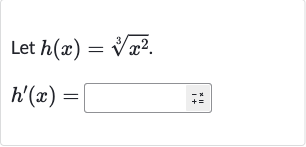AI tutor
Full solution
Q. Let .
- Identify Function: We are given the function . To find the derivative , we will use the chain rule. The chain rule states that if you have a composite function , the derivative is . In this case, our outer function is and our inner function is .
- Derivative of Outer Function: First, we need to find the derivative of the outer function with respect to . We can rewrite this function as , and using the power rule, we find that the derivative .
- Derivative of Inner Function: Next, we find the derivative of the inner function . Using the power rule, the derivative .
- Apply Chain Rule: Now we apply the chain rule. We multiply the derivative of the outer function by the derivative of the inner function. This gives us .
- Combine Terms: We simplify the expression by combining the terms. The in cancels out one of the 's in , leaving us with .
- Simplify Expression: Finally, we can rewrite the expression with a positive exponent by moving to the denominator, which gives us .

